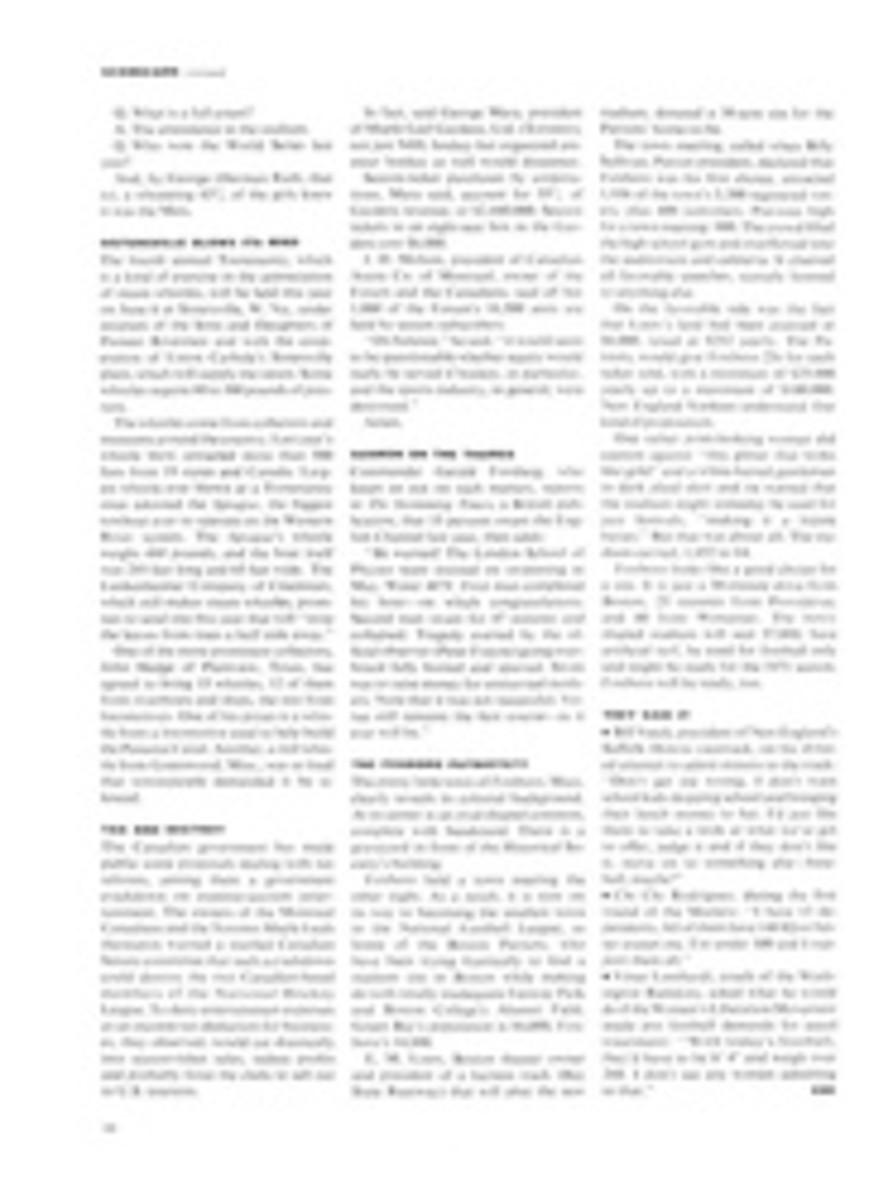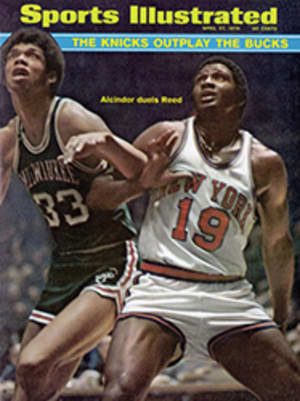
Bucking up the Pakistanis
About the last place anyone might expect to come across a herd of Indian black buck antelope is in New York City, but last week 10 of the animals showed up at J.F.K. International Airport. While representatives of the New York Zoological Society looked on, the antelope, in their wooden crates, were transferred from one airliner to another before embarking on the final stages of a 15,000 mile journey halfway around the world.
Such a journey in itself is no longer a matter of news. Ever since Benjamin Franklin's son-in-law brought the first English ringneck pheasants into the country almost two centuries ago, there has been a steady influx of foreign fauna. In the last several decades so many species of exotic game—as such imports are called—have been introduced into the U.S. that certain areas of the Southwest look more like Africa and Asia
What makes last week's shipment of black bucks news is that the animals were not being imported but exported. In a unique turnabout the black bucks were being sent from Texas back to West Pakistan, where once they were familiar natives and from where, in recent years, they have disappeared. For the first time in the history of modern game management, transplanted animals, several generations removed from their native land, were being returned to it in an effort to repopulate.
The black buck (Antilope cervicapra) is perhaps the most beautiful of all the world's antelope. Its striking color and handsome head make it one of the sportsman's most coveted trophies. When young its coat is a yellowish fawn, and the doe remains this color. But as the buck matures, its coat darkens to a lustrous velvety black, the darkness accentuated by the contrast of pure white chest and undersides.
It is an elegant creature, slight of build (the adult buck weighs about 90 pounds and stands 32 inches at the shoulder) and graceful in its movements. When alarmed it leaps and bounds into the air much the way the impala does, but it can run much faster than the impala or any other antelope. The late E. P. Gee, India's most famous naturalist, wrote of black bucks as "the fastest creatures in the world on four legs."
A plains and open-country animal, this antelope was at one time among the most numerous in India, and black buck hunting with tame cheetahs was a favorite sport of the old maharajas. The cheetah, too, was once common in the country, and the Mogul Emperor Akbar is reported to have kept 1,000 tame cheetahs at his palace for hunting. According to Gee, the Indian cheetah was a better hunter than the African animal. But, wrote Gee in his The Wild Life of India, "a cheetah was not as fast as black buck really, and could only catch them in the initial spurt."
Today the cheetah is extinct in India, and poaching and the pressures of human population have almost eliminated the black buck from its native range. But while the black buck has steadily decreased or disappeared altogether from its normal habitat, it has increased with remarkable vitality in the New World.
Black bucks were first introduced into the U.S., other than as zoo imports, in 1935 by a Texas rancher named Richard Friedrich. Because the antelope adapted so well to the climate and geography of the area, they were an instant success. Soon they were the favorite exotic import on ranches throughout the Southwest and today there are some 6,000 of them in Texas alone, considerably more than have managed to survive in all of India. Zoos now look to the Southwest, not Asia, when they need specimens.
What is more, in Texas it is still possible to add a black buck to one's trophy collection. In India the hunting season has been closed for several years. The hunting in Texas is, of course, on private ranches and for a fee that generally runs about $500 per head. But the heads are well worth the price. On Louis and Ed Stumberg's Patio Ranch near Hunt, where Friedrich, the original owner, freed the first black bucks and where more than a dozen generations of animals have been produced since, numerous record-class heads wander around in the brush.
"We have one big buck," Louis Stumberg says, "that we have not been able to snare or trap no matter how hard we try. He is just so elusive and smart that we cannot track him down. But from the few fast looks I have had at him through glasses, I would say that he probably has as big a head as exists anywhere in the world today. That is a real trophy, but you will have to take my word for it as I am not about to kill him just to measure it."
There are black buck heads almost as fine on many other ranches in Texas, including Charley Schreiner Ill's Y.O. Ranch near Kerrville and Frank Huntress, Guajolote Ranch near Boerne. Last year, in order to round out an impressive collection of game that included almost every major species in Europe and Asia, Nicholàs Franco, a nephew of Spain's Generalissimo, flew to Texas to try for a black buck at the Y.O. Ranch. According to Franco, the head he took was considerably better than any he had seen in India before or after the season was closed.
The idea of reestablishing the black buck in at least part of its original range was a mutual effort involving cooperation—and, perhaps even more important, imagination—on three continents. The pilot work was done by Val Lehmann of King Ranch and Wilbur Matthews of San Antonio, with help from the San Antonio Zoological Society. Their program called for 12 antelope, which were recruited from various ranches with thriving black buck populations. Harry Jersig donated five females and one male from his Auerhahn Ranch in Boerne. Bruno Schulz contributed two males and two females from his Take-It-Easy Ranch in Kerrville. Two additional females came off the ranch of Hal Bradford in Rocksprings.
The San Antonio Zoo, third largest in the nation, agreed to hold the animals in a specially built enclosure while they underwent an observation period and various preshipment tests. King Ranch provided individual custom-built crates for the journey, and a group of cowboys rounded up the skittish animals and put them into the crates. For one afternoon last week this phase of Operation Black Buck took on all the appearances of a full-scale rodeo, with antelope leaping and kicking and cowboys twirling lassos in every direction. In the process two of the females dropped calves and so were themselves dropped from the project.
To cover the cost of the flight of the remaining 10 black bucks from Texas to Pakistan, Game Coin International paid the $1,900 tab. On the other side of the ocean, the World Wildlife Fund handled arrangements for transhipment on the final leg from Frankfurt to Lahore. When the animals finally arrived early last week in Lahore—in excellent condition—their treatment was strictly VIP. General Agha Mohammed Yahya Khan, President of Pakistan, was expected to look at the animals and direct their transfer to the Lal Suhanra Wildlife Sanctuary near Bahawalpur.
This 52,900-acre sanctuary was established in 1968 at the specific urging of Prince Bernhard of The Netherlands, president of the World Wildlife Fund, International and long an impassioned champion of conservation. For the present, the black bucks will live in a large enclosure under the supervision of Pakistani sanctuary officials. It is hoped that in the years to come these animals will become the nucleus of a breeding herd that will eventually repopulate the sanctuary and then the country. The enclosure, the food and the water facilities provided for them at Bahawalpur represent a large gift from the people of Holland who, like their prince, have made the cause of the world's wildlife their own.
It will be years before the outcome of Operation Black Buck can be determined, but even at this early date it is clear that the project represents a giant step in progressive game management. For the U.S., it may prove to be the first step toward making this country a modern Noah's Ark for the world's vanishing wildlife.
PHOTO
A STRUGGLING BLACK BUCK DOE STARTS HER JOURNEY BACK TO THE OLD COUNTRY

